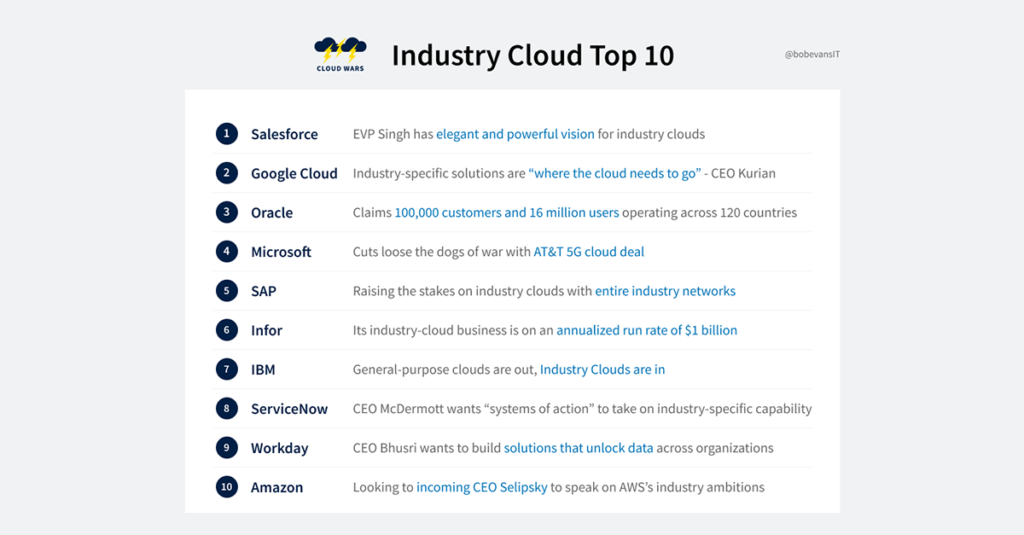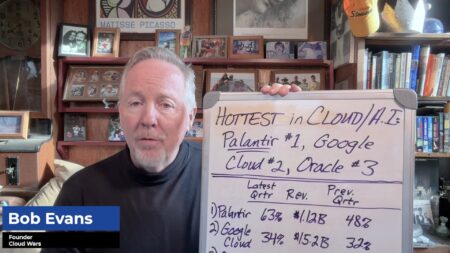Six of the world’s top cloud vendors shared their visions for the future of business as they outlined their approaches to industry clouds on the opening day of the Industry Cloud Battleground Week digital event.
Those companies are helping to drive industry innovation that puts the customer at the center of everything in today’s digital economy, and they all hold significant spots on my Industry Cloud Top 10 rankings: #1 Salesforce, #2 Google Cloud, #3 Oracle, #4 Microsoft, #5 SAP, and #8 Workday.
On Day 1 of Industry Cloud Battleground Week, top executives from these world-changing companies offered strategic overviews of their unique capabilities with their industry cloud solutions, capabilities, and ecosystems. And to give you a sense of those differentiated positions, I’ve pulled out some key highlights from the high-level overviews offered by those executives.
(You can see the entire interviews, plus the entire weeklong program, by registering here—the content is fabulous, timely, and free!)
Salesforce: Industries Executive VP Jujhar Singh
“So Bob, first of all, it’s thanks to our customers that we have been seeing this amazing growth. In fact, in our recent Investors Day, our CFO on September 21st shared that our Industries revenue now is almost $2.9 billion. And a few things have led to this massive growth. The first point is that customers are trying to get digital transformation done in a matter of weeks and no longer years. It’s a secular trend that we see across all industries. And I think industry clouds are a perfect fit for that pre-built data model, processes, analytics compliance out of the box and even integration.
“So I can give you a quick example. PenFed is a customer of ours, and it’s the largest community bank in UK. Once the loans were launched, this ignited a huge call-volume increase, and they wanted to implement chatbots, but they had plans that would require years for that to happen. But, they ended up rolling chatbots in a matter of two weeks…
“And finally, we are in a very unique position because all our industry clouds are baked on one platform. So for us to take our industry offerings and offer them into different industries becomes that much easier. want to learn from others. So that’s also helped…”
Singh also offered some compelling anecdotes:
- Salesforce’s investment in new industry clouds—including Media Cloud and Energy & Utilities Cloud—are “seeing hypergrowth”;
- “on the go-to-market side of the house, I want to point out that our sales organization is almost 55% to 60% vertically aligned by industry”; and
- since 2018, Salesforce has “almost doubled” R&D investments in Industries every year.
Google Cloud: Industries Global Leader Lori Mitchell-Keller
“Hiring executives with deep domain expertise is critical to our overall industry strategy, which is to help companies transform into leading tech companies in their sector. The leaders that I’m hiring have spent decades, literally, in companies within the industry, which allows us to truly understand the challenges our customers are facing.
“What our leaders across each of these priority industries are doing with their teams is developing a portfolio of purpose-built industry solutions to address the business outcomes that matter most to consumers and our customers from those industries. Now it’s easy, I think, for those leaders to be able to better understand those challenges, having been in the industry for quite some time. So the kinds of conversations we’re able to have with our customers are very different than if they were just technology or software people…”
“I couldn’t be more excited about the portfolio of offerings we are building, and more importantly, the results we’re seeing with our customers across industries. For instance, Proctor & Gamble built their Consumer 360 platform using our CDP solution to securely store and activate over 275 million customer records, creating personalized omnichannel journeys for customers around the world. BNY Mellon is another example and use BigQuery and Google Cloud AI to develop a collateral management and liquidity solution that predicted 40% of settlement failures in Fed-eligible securities with an accuracy rate of approximately 90%.
“Ikea used recommendations to AI to increase click-through rate by 30% and generate 400% more relevant recommendations per page, driving a 2% increase in average order value.
“Those are just a few examples of the customers that we’ve been working with, and these results are not because of one-off engagements with these customers, but they’re coming from scaled, repeatable solutions. It’s what the industry cloud is all about, and those solutions we are bringing to market that solve for some of those really complex business challenges.”
Oracle: Executive VP Mark Hura
“If you really think about the portfolio of Oracle broadly, we have horizontal applications, SaaS applications, we have critical infrastructure and leading database technology, both in the cloud and on-premises, in terms of how our customers can utilize that technology. And, one of the real differentiations that Oracle has is the operating technologies in the vertical industries that we operate in. We support 10 vertical industries in a variety of different ways. And these operating technologies are mission critical enterprise-grade systems that are really truly helping these industries, and particularly customers, operate their businesses.
“Some examples are operating technologies in a utility industry in terms of managing the electrical grid in real-time, helping to dictate power flow. And, when there’s an outage, how do they communicate back to their respective customers when the power’s going to be restored? Or how they’re using their consumption of energy and how they can make better choices.
“In communications, it’s operating, whether it’s a 5G network or it’s their core enterprise communications infrastructure network. And, we actually support billions of text messages and phone calls a day, through operating on Oracle. In utilities, we have over 3 billion electric utility, and water, and gas bills that we distribute annually, as examples. And in financial services, we have financial crimes, and risk management, insurance claims, and enrollment, and applications to help members enroll in insurance applications. And then, how do they provide claims and billing back appropriately, in terms of, how they really operate those businesses in a variety of different manners?
“Again, there’s 10 different industries. I won’t go through them all. But, it really is a distinct advantage for Oracle to really understand how those companies are operating and what true business outcomes that they’re trying to derive for their end customers.”
Microsoft: Industry Marketing GM Kees Hertogh
“So for us, looking at each of these industries, looking at what is what is needed, from a schematization perspective, what is needed are common across process flows and core business logic that is specific to that industry. So that’s it. And we infuse that into the Microsoft Cloud. So we make the Microsoft Cloud better and understanding the unique requirements. But we do that in a modular and extensible way, because customers want to address their highest pain points, and then go from there. So they want to start what they need today. They don’t want to wait, they want to start and address high-value pain points right now. And being able to leverage the technology across the Microsoft Cloud stack, but in a way that is preconfigured and has deep awareness of their unique industry requirements. So that’s the work that we’ve done, and how we’re thinking about these industry clouds…
“I think that cocreation is vital not just for us, but for our customers. And again, I think there’s two parts of it: for cocreation, it’s very important to have a common understanding of data, but it’s also important to be able to leverage kind of ‘citizen platform’ technologies like Power Platform to turn those unique requirements directly into solutions with process automation and business intelligence…
“It’s super important for us with industry clouds that they’re designed to be modular and extensible. So yes, we understand our common requirements, but each company is still unique, and each organization wants to start with what they need today as and then adopt and grow from there, and that provides opportunities for our partner ecosystem to deliver that last mile, and deliver on those unique requirements.”
SAP: Industries President Peter Maier
“Today it’s so important to innovate quickly in this dynamic environment… And I think that’s the new kind of speed also from SAP and our approach to reinforce our leadership role in the enterprise application space. I think we are driving the innovation agenda and that’s very important with our customers. So all the innovation cloud solutions from SAP are built jointly with our customers.
“As an example, the oil industry as an example, the customers who come together as a consortium for oil and gas and energy. They really want to co-innovate with us because we understand their business processes and because of our ability to execute. But innovation doesn’t happen in a back room and I think that’s my key message: innovation must be part of a bigger picture around what is the industry doing? And where is the industry going and heading?
“From that point of view, the industry cloud solutions need to be connected to the end-to-end industry processes, not the old ones. And because of that focus on the core process, what that means to our customers and the projects and the prospect in particular is that we have existing but also net new customers in their industry. And this means the industry cloud solutions need to extend SAP’s intelligence with the new vertical capabilities resulting in that model like cloud ERP…
“And we are delivering one industry cloud versus many industry clouds, and that one industry cloud approach is also an important factor. Why? Because the industry boundaries are blowing up and we can’t have industry silos moving forward. So there’s this one cloud approach, SAP’s industry cloud is an important transformation enabler for the customers who move from their home turf to vault into their adjacent industries.”
Workday: Industry Solutions VP Indy Bains
“In every industry, we see customers are looking at how their business model becomes more digital. And as they think about their digital transformation journey, they see that industry capabilities need to be front and center of whatever that cloud platform is that they move to. And for us at Workday, we believe that industry is that final mile. We need to deliver those capabilities, not just in terms of what that industry needs today, but importantly, the reason customers are adopting cloud is because they want to adopt what’s next. That’s what the on-premise world didn’t allow them to do. And whereas in the on-premise world, you could adopt general purpose apps or even industry apps, and then customize them. In the cloud world, you have to rely on your cloud partner to really deliver the capabilities you need. So Workday takes an industry-first approach in our focus industries, where we deliver those industry use cases built into our platform across CFO office, across operations, across CHRO office.
“And what that means for our customers is faster time to value. It allows them to serve their customers better and faster. And I think we see Workday being that backbone of our customers’ enterprise transformation. As they think about how they’re going to innovate in that landscape of solutions, they see Workday as being kind of that core enterprise platform that will allow them to connect into their other investments, whether it’s on-premise, whether it’s other industry-specific apps or homegrown apps, and they can rely on Workday to be that agile, born-in-the-cloud technology platform. That’s delivering those industry-specific capabilities to them. And we do it by putting our industry community at the very heart of that. So we see it very much as a partnership where we’re innovating with the industry, for the industry.”
Hear more from these executives all week
For more powerful insights into industry clouds—the hottest segment within the cloud industry, which after all is the greatest growth market the world has ever known—please join us at Industry Cloud Battleground Week.
RECOMMENDED READING
AWS Snatches Growth-Rate Momentum from Microsoft, Cites Machine Learning
Alphabet CEO Nails It: Why Google Is World’s Hottest Cloud Provider
Beware, Amazon & Google: 4 Horsemen of Microsoft Cloud Apocalypse
Snowflake Leapfrogs IBM on Cloud Wars Top 10 Rankings
SAP Comes Out Swinging against Workday, Oracle; Lays Off Salesforce
Q3 Cloud Forecasts: Microsoft $20.5B, Amazon $15.3B, Google $5.2B, IBM $7.3B
RECENT PODCAST EPISODES
The Facebook Disgrace: Isolated Case | Ammirati on Innovation
Subscribe to the Industry Cloud Newsletter, a free biweekly update on the booming demand from business leaders for industry-specific cloud applications.










